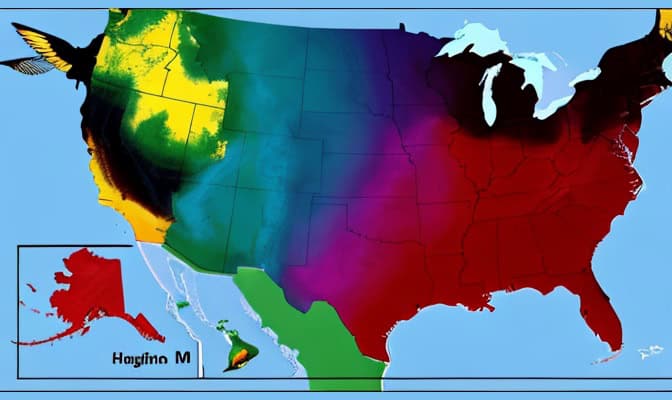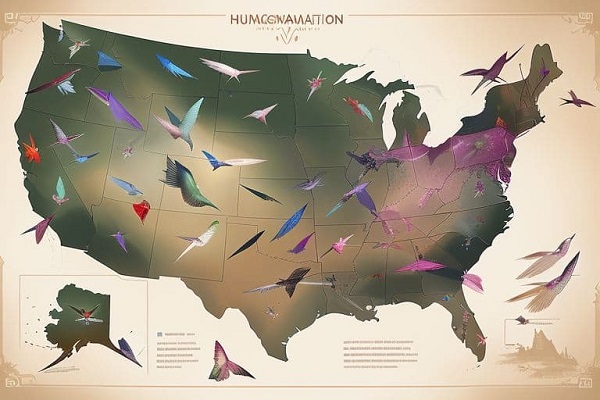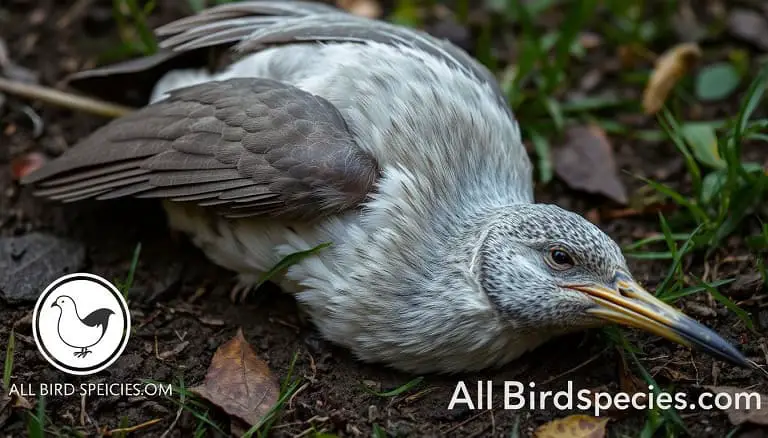Hummingbird Migration Map Guide: Facts and Information
Do you know about Hummingbird Migration Map and their habitat? Hummingbirds are amazing little creatures that travel long distances every year. They make two trips – one north and one south. These journeys can be hundreds or thousands of miles long. It takes a lot of preparation and energy for these tiny birds to make these trips. In fact, hummingbirds are the smallest birds in the world!
In the spring, hummingbirds fly north from South America and Mexico all the way up to Canada. They travel alone and try to get to their breeding grounds early so they can claim the best places to find food. The spring migration may commence as early as February in Mexico and conclude by mid-May in Canada and Alaska.
Then, in the fall, hummingbirds fly south again. They can start this journey as early as late July and the last ones will cross into the southern United States by late October. This amazing cycle of migration can also bring a lot of activity to your hummingbird feeders. If you have a well-maintained feeder, you can expect to see lots of new hummingbirds visiting as they try to get more energy before the next part of their journey.
WHY DO HUMMINGBIRDS MIGRATE?
Hummingbirds are believed to have first appeared in South America after arriving from Asia about 22 million years ago. Over time, some species spread to Central America, the Caribbean, and eventually mainland North America.
One reason these tiny birds started migrating was to find areas with more food. By moving to places with abundant nectar and insects, hummingbirds faced less competition for resources. Additionally, the cooling temperatures in the fall prompted them to fly south each year.

This cycle of moving north in spring and south in fall is the foundation of hummingbird migration patterns. While there are over 300 recognized hummingbird species, only 12-15 regularly migrate into the United States.
The migration of hummingbird is an amazing feat, considering their small size. These little explorers travel long distances alone, navigating their way to find the best food sources and breeding grounds. Their ability to adapt to changing seasons and environments has allowed hummingbirds to thrive and spread across the Americas.
RUBY-THROATED HUMMINGBIRD MIGRATION
Ruby-throated Hummingbirds spend their winters in southern Mexico and northern Panama. Since they are solitary birds, each individual can migrate to any location within this range.
Winter Activities
While their winters may seem like a relaxing getaway, Ruby-throated Hummingbirds are actually busy preparing for their trip back north.
November: Molting
After completing their fall migration, Ruby-throated Hummingbirds begin to molt, or shed, their old feathers. This process can be tiring, so they spend most of their time eating as much nectar and insects as they can find.
December: Gorging
In December, hummingbirds continue to gorge themselves on food to replenish their energy stores. Some Ruby-throated Hummingbirds even stay in the United States through the winter, braving chilly temperatures along the Gulf Coast. Others will winter even farther north, remaining on North Carolina’s Outer Banks all year long.
January: Feeding
January is possibly the slowest time for Ruby-throated Hummingbirds, but it’s still an important period. As their last feathers come in, they focus on feeding and visit dozens of plants each day. Remember, hummingbirds need a lot of nectar to keep their wings flapping!
February: Preparing for Migration
By February, Ruby-throated Hummingbirds’ instincts are kicking in. They know that breeding season is approaching and need to fatten up before flying north. The earliest departures from Mexico and Central America begin in late February, while the majority occur in March.
HOW DO RUBY-THROATED HUMMINGBIRDS MIGRATE?
Ruby-throated Hummingbirds do not migrate in groups. Instead, each bird follows its own instincts to determine when to leave and how to travel.
Environmental Triggers
Scientists believe that hummingbird begin their migration in response to environmental cues. One of these cues is the changing angle and level of sunlight. Another trigger is a decrease in the availability of natural food. As these signals continue to activate, the hummingbird prepares and eventually departs.
Northward Journey
By February, most Ruby-throated Hummingbirds have reached Mexico’s Yucatan Peninsula. This lush jungle is where they feast on insects to prepare for one of the most challenging migrations for any bird. Do you know Every year, thousands of Ruby-throated Hummingbirds opt to fly over the open water of the Gulf of Mexico instead of taking the longer route along the shoreline which is very impressive. These brave birds will fly non-stop up to 500 miles to reach U.S. shores. It takes approximately 18-22 hours to complete this incredible solo flight.
Challenges and Rest
However, not all hummingbirds are strong enough to complete this journey. Numerous oil rig workers and fishing boat crews can confirm that fatigued Ruby-throated Hummingbirds seek temporary shelter on offshore oil rigs and boats drifting in the middle of the Gulf of Mexico. These birds rest for a while before bravely launching back into their flight across the open water.
Return Journey
When Ruby-throated Hummingbirds return south, they follow the same daring migration route in reverse. They recharge their energy reserves in the southern U.S. This is two big, non-stop trips each year for Ruby-throats – a testament to their remarkable tenacity.
Why Do Ruby-throated Hummingbirds Fly over the Gulf of Mexico?
Ruby-throated Hummingbirds do not typically fly over the Gulf of Mexico during their migration. Instead, they follow a land route, often along the coastline, to reach their wintering grounds in Central America and Mexico. This route allows them to stop and rest along the way, refueling on nectar and insects to sustain their high metabolic rate and energy needs.
While it is theoretically possible for some Ruby-throated Hummingbirds to store enough fat to power a non-stop trans-Gulf flight, the risks involved, such as unfavorable weather conditions and lack of food sources, make it a less likely and less safe option for the majority of the species. The Gulf of Mexico crossing is generally considered too risky for Ruby-throated Hummingbirds, and they prefer to stay over land to maintain a continuous food supply during their migration.
In fact, studies have shown that Ruby-throated Hummingbirds tend to follow overland routes, with sightings of the species in the Yucatan Peninsula and other parts of Mexico indicating that they are more likely to migrate over land than over water. Additionally, the Gulf of Mexico is a significant barrier for Ruby-throated Hummingbirds, and they must be careful to avoid harsh weather conditions and other hazards during their migration.
Overall, Ruby-throated Hummingbirds prioritize their survival by choosing a safer and more reliable route that allows them to rest and refuel along the way, rather than attempting a non-stop flight over the Gulf of Mexico.
DIETARY NEEDS OF THE MIGRATING RUBY-THROATED HUMMINGBIRD
Before migrating, Ruby-throated Hummingbirds double their weight from 3 grams to over 6 grams. This extra weight helps fuel their long journey.
Losing Weight During Migration
However, by the time they reach the U.S. shores during their northward migration, a hummingbird’s weight has dropped to around 2.5 grams. This significant weight loss is due to the high energy demands of migration.
High Energy Needs
Hummingbirds have incredible energy needs. Their heart rate can reach 1,200 beats per minute while flying, and their wings flap at least 53 times per second. This high metabolism requires a lot of energy, even on a normal day, let alone during a non-stop flight of hundreds of miles.
Increased Nectar Intake
To meet these energy demands, hummingbirds consume up to 50% of their body weight in nectar each day. During migration, they increase their nectar intake considerably since they don’t know where their next meal will come from. This extra fuel is essential for powering their long journeys.
Check Our Previous Articles
| Hummingbirds In Virginia |
| Pelican Symbolism and Spiritual Meaning |
| Hawks in Michigan |
| Woodpeckers in Washington |
| Owls in Texas |
Frequently Asked Questions About Hummingbird Migration
Q1: Where do most hummingbirds migrate to?
Most hummingbirds migrate to Central and South America.
Q2: Do hummingbirds migrate to India?
No, hummingbirds do not migrate to India.
Q3: What plant attracts hummingbirds the most?
Trumpet creeper, bee balm, and honeysuckle are among the plants that attract hummingbirds the most.
Q4: Do hummingbirds migrate from Arizona?
Yes, some hummingbird species migrate from Arizona to warmer regions during winter.
Q5: Which country do most hummingbirds live?
Most hummingbirds live in Central and South America.
Q6: Where do hummingbirds nest?
Hummingbirds typically nest in trees or shrubs, often in sheltered locations.
Q7: What is the smallest migrating bird in the world?
The Calliope hummingbird holds the title for the smallest migrating bird in the world.







